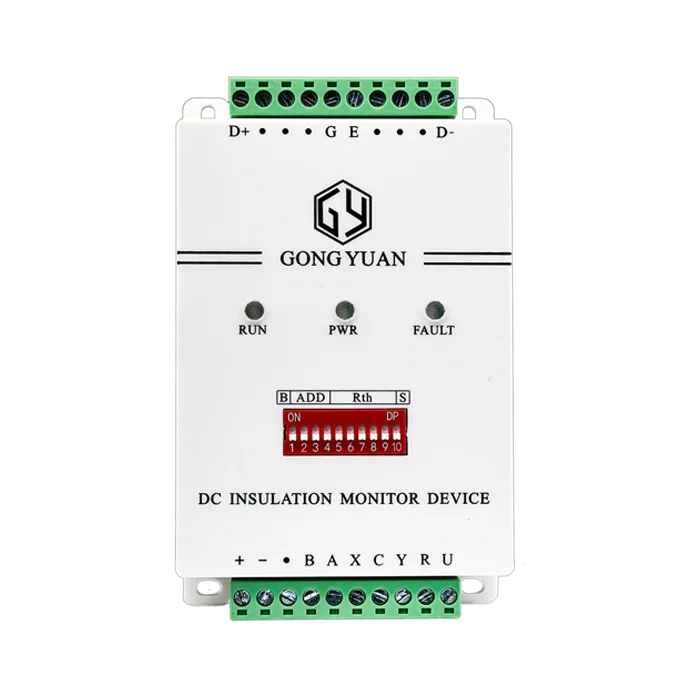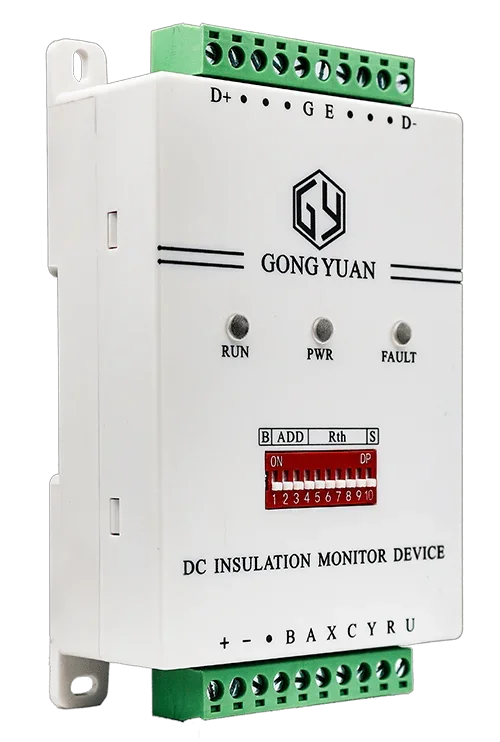Discover the essential tool for electrical safety - the insulation monitor device. This device plays a critical role in safeguarding electrical systems by continuously monitoring insulation resistance, detecting faults early, and preventing hazardous situations. With its ability to provide real-time alerts and ensure compliance with safety standards, the insulation monitor device is a must-have for industries where electrical safety is paramount. Stay ahead of potential risks and protect your equipment, personnel, and premises with this advanced monitoring solution.
Understanding Insulation Monitoring Devices
Role
Insulation monitoring devices play a crucial role in electrical systems by constantly monitoring the insulation resistance between live conductors and earth. They help prevent electrical accidents by detecting faults early.
Insulation faults can lead to equipment damage, production downtime, and even pose serious safety risks to personnel. Detecting these faults promptly is essential to avoid such consequences.
Importance
Early detection of insulation faults is paramount as it allows for timely intervention before catastrophic events occur. By identifying issues such as moisture ingress or deteriorating insulation, maintenance teams can address them proactively.
-
Pros:
-
Prevents electrical accidents
-
Reduces equipment damage
-
Minimizes production downtime
-
Relevance
Adhering to International Electrotechnical Commission (IEC) standards ensures the reliability and accuracy of insulation monitoring devices. These standards provide guidelines for device performance, calibration, and testing procedures.
IEC 61557 series specifies requirements for insulation monitoring devices used in IT systems, ensuring they meet stringent criteria for safety and effectiveness.
Operating Principles of Insulation Monitoring Devices
Connecting Live Conductors and Earth
Insulation monitoring devices connect between live conductors and earth to measure the insulation resistance. This connection allows the device to continuously monitor the insulation level between the electrical circuits and the ground.
Insulation monitoring devices are designed to detect any insulation faults that may occur in the system. By connecting to both live conductors and earth, these devices can effectively measure the insulation resistance and identify any deviations from the normal levels.
Generating Measuring Current
During insulation faults, the device generates a measuring current that flows through the insulation to the ground. This current is used to evaluate the condition of the insulation and detect any abnormalities that could lead to electrical hazards.
The process of generating measuring current plays a crucial role in identifying insulation faults within the electrical circuits. By sending a controlled current through the insulation, the device can accurately assess the integrity of the insulation material and pinpoint any areas of concern.
Significance of Voltage Drop Evaluation
In fault detection, evaluating voltage drops across the insulation is essential for identifying potential issues. Insulation monitoring devices analyze these voltage drops to determine if there are any irregularities that indicate a fault in the system.
Voltage drop evaluation is a critical aspect of fault detection as it helps in pinpointing the exact location of insulation faults within the electrical circuits. By assessing the voltage drops across different points, the device can provide accurate information about the condition of the insulation and ensure timely maintenance to prevent electrical failures.

Measurement Methods in Insulation Monitoring
Partial Discharge Detection
Partial discharge detection is a common measurement method used in insulation monitoring. It involves detecting and analyzing partial discharges within the insulation system. This method is effective in identifying weak spots in the insulation that could lead to future breakdowns.
Partial Discharge Detection:
-
Effective in identifying weak spots
-
Analyzes partial discharges within insulation
Polarization Index Testing
Polarization index testing is another crucial measurement technique utilized in insulation monitoring. It measures the ratio of insulation resistance at different time intervals. This method helps assess the condition of the insulation by comparing the resistance values at various points in time.
Polarization Index Testing:
-
Measures ratio of insulation resistance at different time intervals
-
Assesses insulation condition by comparing resistance values
Dielectric Absorption Ratio Measurement
Dielectric absorption ratio measurement is a valuable measurement method for insulation monitoring. It evaluates how well the insulation recovers after being subjected to a high voltage for a specific period. This method aids in understanding the long-term performance of the insulation material.
Dielectric Absorption Ratio Measurement:
-
Evaluates recovery of insulation after high voltage exposure
-
Aids in understanding long-term performance of insulation material
Importance of Accurate Differentiation
Accurate differentiation between leakage currents and insulation resistance is crucial in insulation monitoring. Resistance measurements help determine the health of the insulation system, while leakage currents indicate potential faults or degradation. Understanding and accurately interpreting these parameters are essential for maintaining system reliability.
Accurate Differentiation:
-
Crucial for determining health of insulation system
-
Indicates potential faults or degradation
Superimposing DC Voltage Technique
Principle
When superimposing DC voltage for insulation monitoring, a small DC voltage is added to the AC supply. This technique involves injecting a measuring DC voltage into the system to measure the voltage drop across the insulation.
By measuring the corresponding voltage drop, the device can detect any insulation faults present in the system. This method relies on analyzing the changes in voltage levels to pinpoint potential issues accurately.
Effectiveness
The superimposing DC voltage technique is highly effective in detecting insulation faults in electrical systems. It offers a precise way to identify any weaknesses in the insulation, ensuring early detection of potential hazards.
This technique is particularly useful in DC voltage systems where traditional methods may fall short. By superimposing a DC voltage, the device can provide real-time monitoring and immediate alerts in case of any insulation breakdown.
Advantages over Traditional Methods
-
Real-time Monitoring: Unlike traditional techniques that may have delays in detecting faults, the superimposing DC voltage method offers instant feedback.
-
Increased Accuracy: This technique provides more accurate results by directly measuring the voltage drop across the insulation.
-
Early Detection: By promptly identifying insulation faults, this method helps prevent major electrical issues and ensures system safety.
AMP Measurement Technique
Patented Method
The AMP measurement method utilized by Bender stands out as a patented technique in the realm of insulation monitoring devices. This innovative approach offers unparalleled accuracy and reliability in measuring amp levels within electrical systems. Developed with precision engineering, this method ensures precise readings for enhanced safety and performance.
Automatic Adjustment to System Conditions
One key feature of this method is its ability to automatically adjust to varying system conditions. By dynamically adapting to changes in the environment, such as fluctuations in temperature or voltage, the AMP measurement technique guarantees consistent and precise results. This adaptability is crucial for maintaining optimal performance and ensuring the safety of electrical systems.
Interference Suppression for Accuracy
An essential aspect of achieving reliable measurements is interference suppression. The AMP measurement technique by Bender incorporates advanced technologies to mitigate external influences that could affect the accuracy of readings. By suppressing interference from external sources, such as electromagnetic fields or other electrical equipment, this method ensures the integrity of the measured ac voltage, leading to highly accurate results.

Benefits of Insulation Monitoring Systems
Early Detection
Insulation monitoring systems offer early fault detection by continuously monitoring the insulation resistance. This proactive approach allows for prompt identification of insulation faults before they escalate, minimizing downtime and preventing potential hazards.
Automatic Localization
One key advantage is the automatic localization of faults provided by these systems. By pinpointing the exact location of insulation issues, maintenance teams can swiftly address the problem, reducing troubleshooting time and enhancing operational efficiency.
Operational Efficiency
Insulation monitoring systems play a crucial role in enhancing operational efficiency. By detecting faults early and providing automatic localization, these systems enable organizations to streamline maintenance processes, optimize resource allocation, and improve overall system reliability.
Resource Planning
Another significant benefit is how these systems contribute to effective resource planning. With early fault detection and automatic fault localization, organizations can better allocate resources, schedule maintenance activities efficiently, and prevent unexpected downtime, ultimately saving costs and improving productivity.
Safety Improvement
Insulation monitoring systems are instrumental in improving overall safety within various applications. By promptly identifying insulation faults, these systems help prevent electrical accidents, fires, and equipment damage, ensuring a safer working environment for personnel and protecting valuable assets.
Enhancing Safety with Insulation Monitoring
Accident Prevention
Insulation monitoring plays a crucial role in preventing accidents by continuously monitoring the insulation level of electrical installations. By detecting insulation faults promptly, these devices ensure that any potential risks are identified before they escalate. In the event of an insulation fault, the system can locate the fault precisely, allowing for immediate intervention to prevent accidents.
Improved Electrical Installation Conditions
Enhanced electrical installation conditions resulting from insulation monitoring lead to improved safety measures. By maintaining the integrity of the insulation and identifying any deviations in the insulation level, these systems create a safer environment for both individuals and equipment. The ability to detect asymmetrical and symmetrical insulation faults ensures comprehensive coverage, reducing the likelihood of accidents caused by insulation issues.
Timely Maintenance Alerts
Timely maintenance alerts provided by insulation monitoring devices are essential for reducing risks associated with electrical installations. These alerts notify operators of any changes in the insulation level or the presence of insulation faults, enabling them to take immediate action. By addressing issues promptly through maintenance interventions, the risks of electrical shocks, fires, and other accidents are significantly minimized.
Optimizing Maintenance with Monitoring
Centralized Systems
Insulation monitoring systems provide real-time data on insulation resistance, enabling proactive maintenance to prevent costly downtime. By evaluating insulation components, these systems detect faults early, allowing for timely repairs.
Centralized evaluation of insulation data from various sources streamlines maintenance processes in industrial plants. This centralized approach enhances the efficiency of maintenance teams by providing a comprehensive overview of the entire electrical system.
Enhanced Decision-Making
Access to centralized information through a dedicated website or platform empowers maintenance personnel to make informed decisions promptly. With all relevant information accessible in one location, maintenance teams can prioritize tasks based on criticality and urgency.
Maintenance notes and historical data stored centrally offer valuable insights into past issues, aiding in identifying recurring problems and implementing long-term solutions. This centralized approach ensures that maintenance decisions are based on accurate and up-to-date information.
Prolonging Lifespan
Regular monitoring of insulation rating and performance allows for timely interventions to address potential issues before they escalate. By localizing faults promptly, maintenance teams can rectify problems at an early stage, thereby extending the lifespan of electrical installations.
The use of insulation monitoring as a basis for maintenance schedules specifies regular checks and testing, ensuring that electrical systems remain in optimal condition. This proactive approach minimizes the risk of unexpected failures, enhancing overall system reliability.
Response Time and Bender Devices
In the event of a fault, rapid response is crucial to minimizing downtime and preventing damage to equipment. Insulation monitoring systems trigger alarms immediately upon detecting anomalies, prompting swift action from maintenance personnel.
Bender insulation monitors are widely used in various countries for their reliability and accuracy in detecting insulation faults. These devices play a key role in maintaining electrical safety standards and ensuring continuous operation of critical systems.

Closing Thoughts
The comprehensive exploration of insulation monitoring devices has shed light on their critical role in ensuring electrical safety and system reliability. Understanding the operating principles, measurement methods, and benefits associated with these devices is paramount for industries where electrical insulation integrity is a top priority. By implementing insulation monitoring systems, organizations can not only enhance safety measures but also optimize maintenance practices, leading to improved operational efficiency and risk mitigation.
To stay ahead in the realm of electrical safety, it is imperative for professionals and organizations to embrace the advancements in insulation monitoring technology. By incorporating these systems into their infrastructure and adhering to best practices outlined in this discourse, they can fortify their operations against electrical faults and downtime. Continuous learning and proactive implementation of insulation monitoring solutions will undoubtedly pave the way for a safer and more resilient electrical environment.
Exploring the Functionality and Benefits of Insulation Monitor Devices
